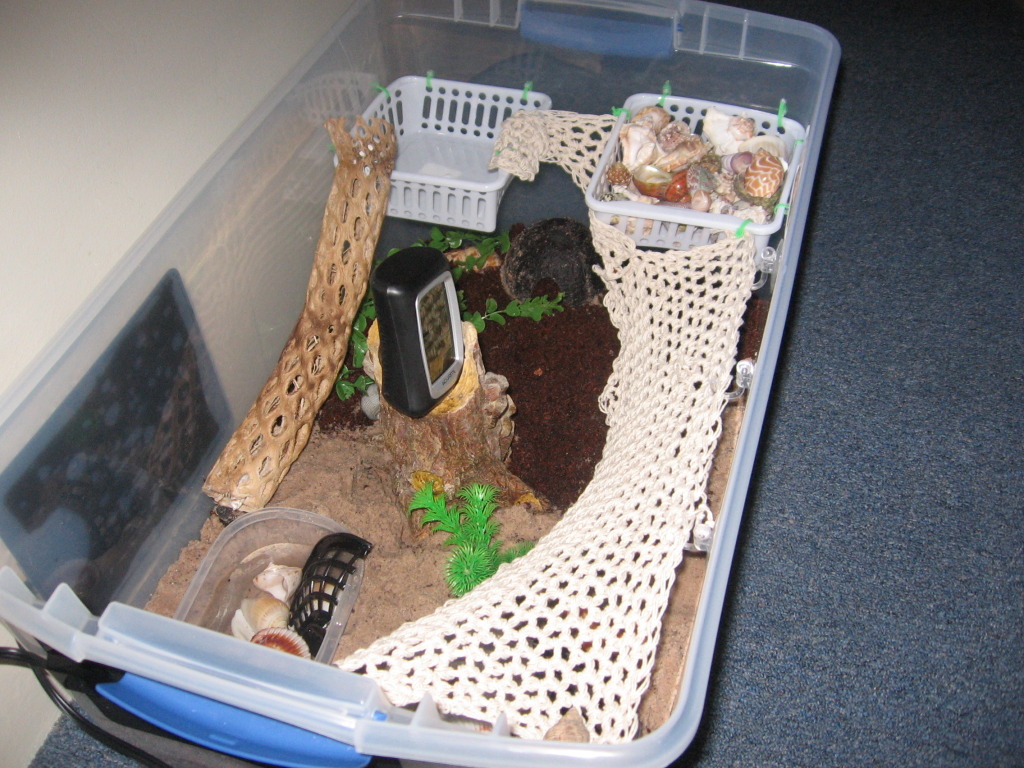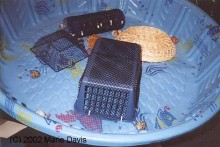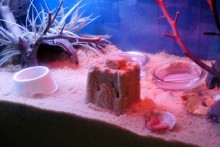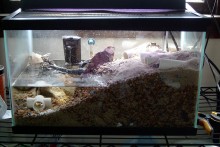DIY Hermit Crab Habitat
Use plastic containers to make a habitat for your hermit crabs! Remove the lid from a plastic storage bin, pour in six inches of sand, and consider adding coconut fiber on one side. Hang plastic baskets on the walls with zip ties, and use suction cups to hang pieces of a net around the walls for your crabs to climb. To make pools, put some rocks or seashells in two plastic containers for your crabs to use to climb out of the containers, bury the base of the containers in the substrate, and fill one pool with dechlorinated fresh water and the other with saltwater. Make a natural hide by cutting a hole out of the side of a plastic bowl, painting the bowl with nontoxic glue, and rolling the bowl in sand or coconut fiber. Regularly moisten the soil, fill the baskets with seashells for your crab to change into or a moss garden for humidity, and add plants and other decorations your crab can climb. Place a thermometer in the cage to monitor the temperature for your pets and a hygrometer to measure the humidity.






What do you do for the lid on this? I can’t believe I never thought of using a plastic tub! This is great!
Amanda,
You can use the lid that comes with the plastic container; just drill or poke holes in the lid to allow for ventilation. Another option is to make a ventilation window: draw a square or rectangle on the lid, cut out the shape and tape a piece of mesh over the hole. Be sure to make the ventilation window in a location that your crabs cannot access. If you live in a very humid environment like Florida, you can leave the lid off the container as long as the crabs are unable to climb to the top of the container.
What is a good size? Which size did you use?
Skylar,
How much space you need depends on the size and number of crabs that you have. If you have two small hermit crabs, you heed at least a ten gallon habitat with at least 5-6 inches of substrate depth. (Ten gallons is the size of the most common glass aquariums.) However, it is always nice to get them the biggest environment possible; hermit crabs love to roam and climb.
Source: Hermit Crab Association – Crabitat: Tank Size, Crab Size & How Many Can You Have?
Will the heat pad melt the sides?
Mick,
The melting temperature is different for each type of plastic. If you keep the heating pad on a very low temperature (and conduct some tests in a well-ventilated area to ensure there aren’t any fumes), it could be fine. You could also consider connecting the heating pad to a timer so that it is not continuously heating the plastic. As an alternative to a heat pad, you could use a heat lamp. If you use a heat lamp though, make sure to keep it towards one side of the tank so that the crabs can to move to a cooler area of the tank if they need to.
If you have any doubts or concerns about the heat pad, just use a glass tank instead. You can make your own with some glass panels and aquarium silicone. See this post for more information on that: DIY Glass Aquarium.
I just upgraded to one of these and I’m a bit nervous about the heat pad placement. I know it should be to the side and most likely on the same side as the lighting. It will be meant to help keep some substrate warm. I have a 4 watt mini reptile under-tank heater. Would this even be a feasible idea?
Barbara,
Since the heater is meant to go under a tank, it certainly sounds feasible, but since hermit crabs have a much greater substrate depth than a reptile tank does, I don’t know how far the heat will travel through the substrate. You can test it out and insert a thermometer to various depths within the substrate to find out, letting the thermometer reset between each depth test. Even if the top of the soil doesn’t get the added heat, when the crabs dig down to molt, they might appreciate finding it. Just in case they don’t like it, you could put the heating pad toward one side of the heated area (instead of in the center of the heated area), or if that’s not possible, don’t worry about it since they can always just choose an area a few inches away if they prefer.
If the temperature doesn’t go all the way up through the substrate, you could dig some grooves into the sand over that area so that when they walk into a groove, they will find the heated substrate. Once they know where it is, you can try refilling the grooves to see if they can still find it (still prefer molting or digging in that area). Keep in mind that each crab is unique, so one may prefer digging in the heated area, while another prefers digging in a cooler area.
Thanks, I am using it just to heat the warm side of the crabitat’s substrate and I don’t have it constantly on either. I use a heat lamp mainly, but sometimes at night the room becomes too cold, even with the home being heated, and my crabs love being under quite a bit.
Oh this is a great idea! But you need to put deeper substrate in your tank.